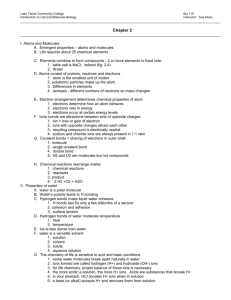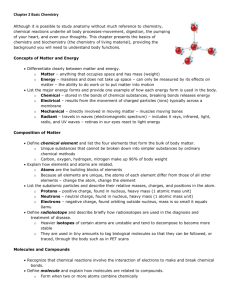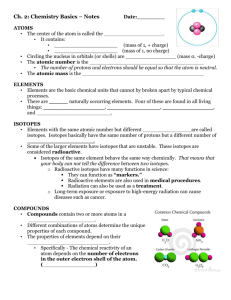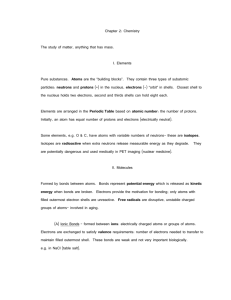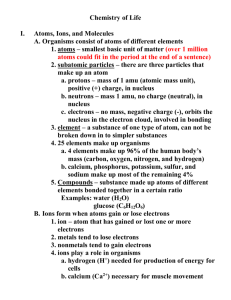intro to chemistry - Fulton County Schools
advertisement
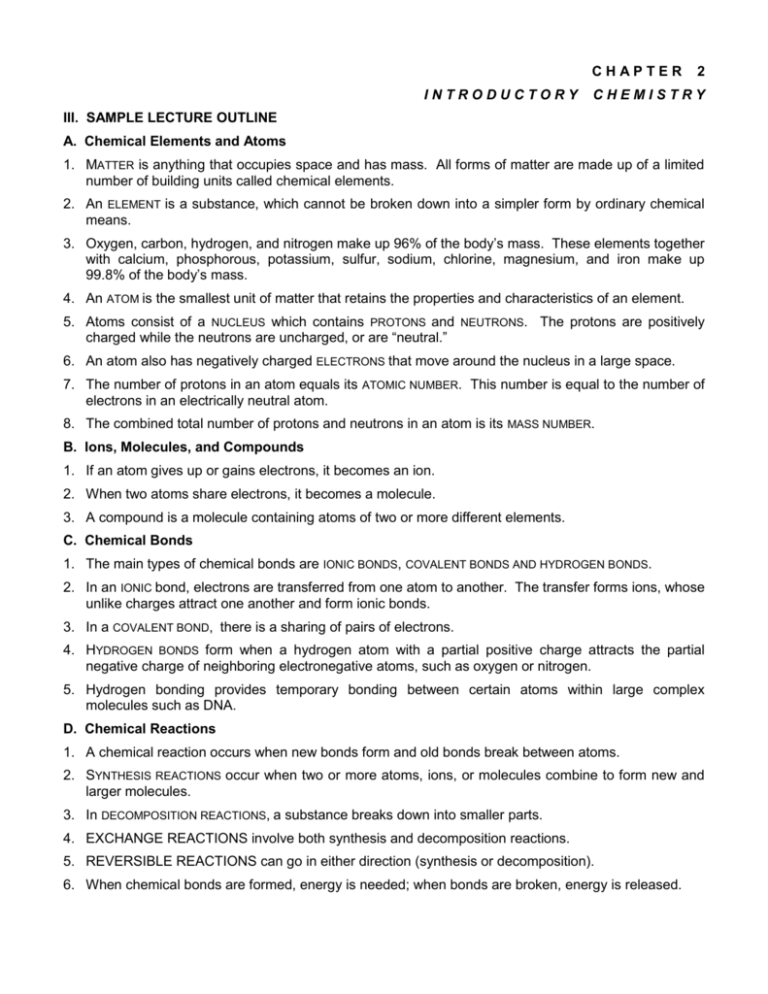
CHAPTER INTRODUCTORY 2 CHEMISTRY III. SAMPLE LECTURE OUTLINE A. Chemical Elements and Atoms 1. MATTER is anything that occupies space and has mass. All forms of matter are made up of a limited number of building units called chemical elements. 2. An ELEMENT is a substance, which cannot be broken down into a simpler form by ordinary chemical means. 3. Oxygen, carbon, hydrogen, and nitrogen make up 96% of the body’s mass. These elements together with calcium, phosphorous, potassium, sulfur, sodium, chlorine, magnesium, and iron make up 99.8% of the body’s mass. 4. An ATOM is the smallest unit of matter that retains the properties and characteristics of an element. 5. Atoms consist of a NUCLEUS which contains PROTONS and NEUTRONS. The protons are positively charged while the neutrons are uncharged, or are “neutral.” 6. An atom also has negatively charged ELECTRONS that move around the nucleus in a large space. 7. The number of protons in an atom equals its ATOMIC NUMBER. This number is equal to the number of electrons in an electrically neutral atom. 8. The combined total number of protons and neutrons in an atom is its MASS NUMBER. B. Ions, Molecules, and Compounds 1. If an atom gives up or gains electrons, it becomes an ion. 2. When two atoms share electrons, it becomes a molecule. 3. A compound is a molecule containing atoms of two or more different elements. C. Chemical Bonds 1. The main types of chemical bonds are IONIC BONDS, COVALENT BONDS AND HYDROGEN BONDS. 2. In an IONIC bond, electrons are transferred from one atom to another. The transfer forms ions, whose unlike charges attract one another and form ionic bonds. 3. In a COVALENT BOND, there is a sharing of pairs of electrons. 4. HYDROGEN BONDS form when a hydrogen atom with a partial positive charge attracts the partial negative charge of neighboring electronegative atoms, such as oxygen or nitrogen. 5. Hydrogen bonding provides temporary bonding between certain atoms within large complex molecules such as DNA. D. Chemical Reactions 1. A chemical reaction occurs when new bonds form and old bonds break between atoms. 2. SYNTHESIS REACTIONS occur when two or more atoms, ions, or molecules combine to form new and larger molecules. 3. In DECOMPOSITION REACTIONS, a substance breaks down into smaller parts. 4. EXCHANGE REACTIONS involve both synthesis and decomposition reactions. 5. REVERSIBLE REACTIONS can go in either direction (synthesis or decomposition). 6. When chemical bonds are formed, energy is needed; when bonds are broken, energy is released. E. Inorganic Compounds 1. Inorganic substances lack carbon, are structurally simple, and hold together by ionic or covalent bonds. 2. Examples of inorganic compounds include: water, carbon dioxide, bicarbonate, acids, bases, and salts. 3. Water is the most abundant and important substance in the body. It is an excellent solvent, participates in chemical reactions, absorbs and releases heat slowly, and lubricates. Water is involved in digestion, the elimination of wastes, circulation, and the regulation of body temperature. 4. Inorganic acids, bases, and salts dissociate into ions in water. Cations are positively charged ions; anions are negatively charged ions. An acid ionizes into H+ ions and a base ionizes into OH-ions. 5. The pH of different parts of the body must remain fairly constant for the body to remain healthy. The pH SCALE extends from 0 to 14 with 7 representing neutral. Values below 7 indicate ACID solutions, and values above 7 represent BASIC (alkaline) solutions. 6. The pH values of different parts of the body are maintained by buffer systems which consist of weak acids and bases. Buffer systems covert strong acids or bases into weak acids or bases in order to maintain pH homeostasis. F. Organic Compounds 1. Organic substances always contain carbon and hydrogen, and always have covalent bonds. 2. CARBOHYDRATES are sugars, glycogen, and starches, and are the most common sources of energy needed for life. They may be monosaccharides, dissacharides, or polysaccharides. Carbohydrates, and other organic molecules, are joined together to form larger molecules through a process called DEHYDRATION SYNTHESIS. In the reverse process, called digestion, HYDROLYSIS occurs in order to break down large molecules, with the addition of water. 3. LIPIDS are a family group of compounds that include triglycerides (fats or oils), phospholipids, steroids, fatty acids, and fat soluble vitamins (Vitamins A, D, E, and K). Fats protect, insulate, and provide energy. 4. The most plentiful lipids in your body and your diet are the triglycerides. 5. PROTEINS are constructed from amino acids. They give structure to the body, regulate enzyme processes, provide protection, and help to contract muscle. 6. DNA and RNA are nucleic acids consisting of nitrogenous bases, sugar and phosphate groups. DNA is a double helix and is the primary chemical in genes. RNA differs in structure and chemical composition from DNA and is mainly concerned with protein synthesis reactions. 7. The principal energy-storing molecule in the body is ATP. ATP decomposes to yield ADP and energy. ATP is manufactured from ADP and phosphate, primarily by using the energy supplied by the decomposition of glucose.



